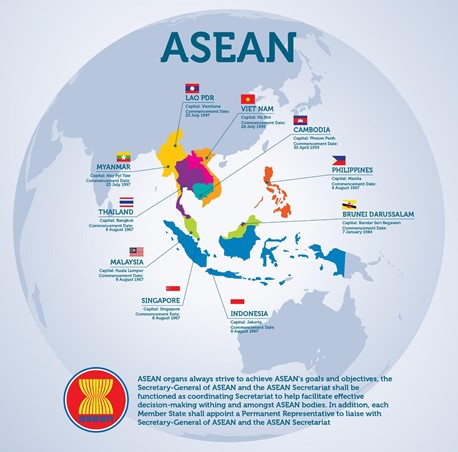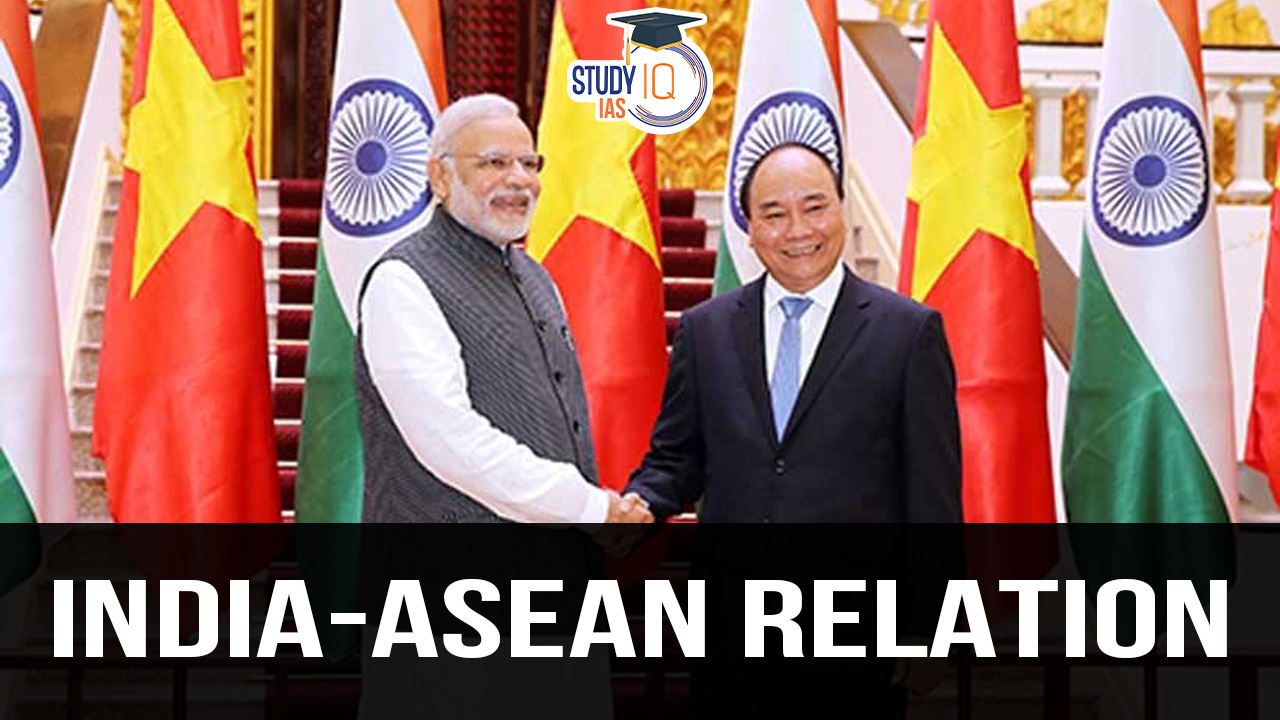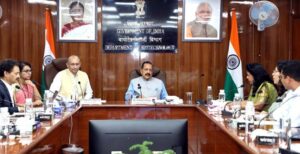Table of Contents
Association of Southeast Nations (ASEAN)
- Established: On 8 August 1967 by ASEAN Declaration (Bangkok Declaration)
- Members:
- Founding: Indonesia, Malaysia, Philippines, Singapore and Thailand.
- Current Members (10): Brunei, Cambodia, Indonesia, Laos, Malaysia, Myanmar, the Philippines, Singapore, Thailand, and Vietnam.
- India is not a member.

- Motto: “One Vision, One Identity, One Community”.
- Objective: To accelerate economic growth, social progress and cultural development through joint endeavours in the spirit of equality and partnership in order to strengthen the foundation for a prosperous and peaceful community of Southeast Asian Nations.
- The ASEAN Summit: It is the highest policy-making body in ASEAN comprising the Head of States or Government of ASEAN Member States.
- It is headed by a chair—a position that rotates annually among member states—and is assisted by a secretariat based in Jakarta, Indonesia.
- Institutional mechanisms for engaging ASEAN
- ASEAN-India Summit: This is at the apex and is an annual summit.
- ASEAN-India Foreign Ministers Meeting: It supports the ASEAN-India Summits by meetings at the Foreign Minister level.
- ASEAN-India Ministerial: Here, Indian line ministries interact with their ASEAN counterparts through sector-specific dialogue mechanisms. Some of the important sectoral bodies are business and trade, energy, education, etc.
- ASEAN-India Senior Officials Meeting: It is an annual Secretary level meeting, co-chaired by Secretary (East) from the Indian side and counterpart Secretary from the Country Coordinator from the ASEAN side.
India and ASEAN Relations
Evolution of Partnership
- 1992: India began formal engagement with ASEAN by becoming a Sectoral Dialogue Partner.
- 1995: The relationship was elevated to a Dialogue Partnership, with interactions expanding to the Foreign Minister level.
- 2002: India-ASEAN relations were upgraded to the Summit level, with the first summit held in 2002.
- 2012: At the 20-year Commemorative Summit in New Delhi, the Dialogue Partnership was elevated to a Strategic Partnership.
- 2018: During the 25-year Commemorative Summit, both parties agreed to strengthen cooperation in the maritime domain.
- 2022: The 30th anniversary of ASEAN-India relations was celebrated as ASEAN-India Friendship Year, marking the elevation of the Strategic Partnership to a Comprehensive Strategic Partnership.
Cooperation
Economic Engagements
- Bilateral Trade: Over the last decade, India’s trade with ASEAN has nearly doubled, crossing USD 130 billion.
- Investment: Foreign Direct Investment (FDI) flows from India into ASEAN experienced an increase from US$ 2.04 billion in 2022 to US$ 5.63 billion in 2023.
- The Framework Agreement on Comprehensive Economic Cooperation (CECA): The CECA was signed in 2003 and came into force in 2010.
- It is a free trade agreement between India and ASEAN that aims to eliminate tariffs on most goods traded between the two regions.
- Three agreements that were signed under CECA are :
- The India-ASEAN Trade in Goods Agreement (AITIGA): The AITIGA was signed in 2009 and came into force in 2010. It is a trade agreement between India and ASEAN that aims to eliminate tariffs on most goods traded between the two regions.
- The India-ASEAN Agreement on Trade in Services (ATIS): The ATIS was signed in 2014 and came into force in 2017. It is an agreement between India and ASEAN that aims to liberalise trade in services between the two regions.
- The India-ASEAN Agreement on Investments (AII): The AII was signed in 2016 and came into force in 2022. It is an agreement between India and ASEAN that aims to promote and protect investments between the two regions.
Defence & Security
- India and ASEAN conducted their inaugural ASEAN-India Maritime Exercise (AIME) from May, 2023.
- Besides this, India has bilateral exercises with individual countries like SIMBEX, CORPAT etc.
- India and ASEAN agreed to strengthen cooperation in:
- Maritime security
- Counter-terrorism
- Cybersecurity
- Military medicine
- Transnational crime
- Humanitarian assistance
- Disaster relief
- Peacekeeping and demining operations
- Cooperation will involve joint military exercises, naval port calls, and defence scholarships.
Socio-Cultural Cooperation
- Over the years, ASEAN-India socio-cultural cooperation has expanded to include various sectors such as human resource development, people-to-people contacts, cultural exchanges, education, health, biodiversity, climate change, and disaster management.
- These projects are supported by the ASEAN-India Fund and the ASEAN-India Green Fund.
- Support for ASEAN Integration Initiative (IAI): India actively contributes to the Initiative for ASEAN Integration (IAI) by implementing projects like:
- Scholarships for students from CLMV countries for two-year Masters programs at Nalanda University.
- Establishment of Entrepreneurship Development Centres (EDCs) and Centres for English Language Training (CELT) in CLMV countries.
- Creation of the ASEAN-India Network Universities (AINU) and provision of Masters and Doctoral scholarships for ASEAN students in India.
People-to-People Contacts
- India is the first Dialogue Partner to sign an MoU on Strengthening Tourism Cooperation with ASEAN.
- ASEAN and India organise regular programs to enhance people-to-people interactions, such as:
- ASEAN-India Students Exchange Programmes
- Special Course for ASEAN Diplomats
- Delhi Dialogue
- International Conference on ASEAN-India Cultural and Civilizational Links
- ASEAN-India Media Exchange Programme
- ASEAN-India Youth Summit
- Commemorative events like the ASEAN-India Artist Camp 2022 and ASEAN-India Music Festival marked the 30th anniversary of ASEAN-India relations.
Health Cooperation Amid COVID-19
- In July 2023, a Conference on Traditional Medicine focused on the role of traditional medicine in mitigating the COVID-19 pandemic in India and ASEAN.
- Additionally, a workshop on the National Cancer Grid Visham Global Cancer Project was held in August 2023, facilitating information exchange on COVID-19 mitigation and treatment.
- Exploration of New Cooperation Areas: ASEAN and India are exploring partnerships in various emerging sectors, such as:
- Cybersecurity, Science & Technology, and Digital Economy
- Green and Blue Economy
- Fintech, MSMEs, Start-ups, and Finance
- Energy, Food Security, and Space
- Public Health, Smart Cities, and Technical and Vocational Education and Training (TVET)
| Significance of Southeast Asia for India |
Strategic Importance:
Economic Opportunities:
Cultural and Historical Ties:
Technology and Innovation:
|
| Key Developments in Recent Summit |
10-Point Plan Announced by India
Scholarships for ASEAN Students:
Other Developments
|
Contemporary Challenges in Relations
- Trade Imbalance: Despite strategic and diplomatic success, India faces challenges in trade relations with Southeast Asia.
- The decision to opt out from the Regional Comprehensive Economic Partnership (RCEP) disappointed several countries in the region, particularly Singapore who had strongly advocated for India’s participation.
- Competition from China: China’s strong economic and geopolitical influence in Southeast Asia poses a challenge for India.
- The region is heavily dependent on China for trade and infrastructure investments, making it harder for India to compete for influence.
- Geopolitical Complexities: The growing US-China conflict has complicated the regional dynamics, with Southeast Asia often caught in the middle.
- India as a member of QUAD faces the challenge of balancing its relationships with ASEAN nations and addressing concerns about India aligning too closely with the US and its allies.
- Defence Cooperation: Although India is working on strengthening defence and security cooperation with Southeast Asia, the region’s historical non-aligned stance means that countries remain cautious of military engagements, especially amid heightened tensions in the Indo-Pacific.
- Implementation of Agreements: India has initiated several strategic agreements in the technology sector like semiconductors but translating these agreements into actionable outcomes remains a challenge.
Way forward
- Age of Minilateralism: India should not be shy of exploring them in Southeast Asia as ASEAN will continue to struggle with its internal cohesion.
- Strong Bilateral Partnerships: There should be a concerted attempt by India to develop strong bilateral partnerships with like-minded partners within ASEAN so that India doesn’t get sidelined due to inroads by USA and China.
- Continuous Engagement: As India and ASEAN differ in terms of their perspectives on several issues, it is important for both to continue engaging each other to avoid any misunderstanding and to address them in a mutually beneficial manner.
- New Priority Areas: Both sides identified resilient supply chains, food security, energy security, health and financial stability as priority areas of cooperation in the latest ASEAN Economic Ministers – India Consultation in August, 2023.
- Digital Economy: ASEAN is one of the fastest growing digital economy regions in the world. India has a role to play in this as it has a vast and burgeoning start-up sector with a digitally proficient human capital base.
- Humanitarian and Disaster Relief Cooperation: Collaborative efforts in disaster relief and humanitarian assistance can enhance mutual trust and goodwill. Sharing best practices, expertise, and resources during times of crisis can strengthen the bond between India and ASEAN countries.


 Bharat Bandh 9 July 2025: Over 25 Crore ...
Bharat Bandh 9 July 2025: Over 25 Crore ...
 Sukhoi Su-57: Will India Choose Russia�...
Sukhoi Su-57: Will India Choose Russia�...
 World Bioproduct Day 2025: Date, Theme, ...
World Bioproduct Day 2025: Date, Theme, ...





















